When you hear the name Patrick Murray do shamrocks come to mind? Most likely! The Scots-Irish (Scotch-Irish) Migration brought many families to North America in the 18th and 19th centuries and Patrick's ancestors settled in the Carolinas. In 1982 Patrick's career transferred him from North Carolina to Chicago, Illinois. In 1990 I was accepted into the University of Chicago graduate program and took a position in the same company where Patrick was employed. We met and married in Chicago in 1992. The City of Chicago boasts a large Irish population. Chicago celebrates St. Patrick's Day as fully as it can possibly be celebrated. Even the river is dyed green!
 |
| One block from where Jeanette lived and a block from where Patrick and Jeanette met. |
As you've probably already guessed, we're going to share with you some Irish recipes. If you were here we would make you a green beer, Chicago style!
Like all traditional cultural cuisines, Irish cuisine if influenced by the crops grown and animals farmed in that climate. In the second half of the 16th century the potato was introduced which heavily influenced Ireland's cuisine thereafter. Traditional Irish recipes tend to be simple and hearty, and nothing is wasted. As the saying goes, every part of the pig is eaten except the oink! Traditional recipes would include Bacon and Cabbage, Irish Stew, Leek and Potato Soup, Nettle Soup, Irish Soda Bread, Irish Brown Bread, Spotted Dog, Colcannon, and Champ. A great website for these recipes and some fun history is here: http://www.dochara.com/the-irish/food-recipes/traditional-foods-of-ireland/
Today is the last Saturday of November and Patrick is hunting deer. He has already harvested one which has been processed and is in the freezer for the winter. The deer population is quite heavy in our area and the hunting season extends from early September until late December and sometimes even January. Patrick hunts with bow and muzzleloader. The temperatures have dropped and he will be chilled when he comes home for a mid-day meal. I'm going to make something from our CBS Homemakers Exchange Recipes booklets - Irish Stew and Irish Soda Bread.
 |
| January, February, March 1951 |
 |
| The ingredients for Irish Stew - lamb, onion, carrots, turnips, potatoes, and peas for garnish. |
I really don't remember ever having eaten a turnip and I certainly don't remember how to prepare one! Some internet research gives me the tip of cutting off the ends to create a flat surface and then peeling from the top down, flipping the turnip over, and peeling the remainder. A great tip to prevent peeling too much flesh off the turnip, or peeling any flesh off my fingers!
 |
| A turnip successfully and painlessly peeled. |
 |
| The lamb is cut and browned in oil. |
 |
| Onion is sliced and cooked until tender. |
 |
| A bay leaf added, covered with water, and all allowed to simmer for 1-1/2 hours. Yes, the aroma is wonderful! |
 |
| The carrots are sliced, potatoes and turnips peeled and diced, and all simmered for 30 minutes. (Tummy tells me I'm getting hungry!) |
 |
| January, February, March 1950 |
 |
| Ingredients for Irish Soda Bread. |
 |
| Dry ingredients are mixed, then shortening is cut in with pastry blender. |
 |
| Raisins and caraway seeds added. |
 |
| Buttermilk and vinegar mixed, added to dry ingredients, and blended with a fork. |
 |
| Batter is transferred to a greased pan and patted flat. |
 |
| Baked until golden. (Now I'm really, really hungry!) |
 |
| Not quite so hungry now. I had to try it, didn't I? *grin* |
 |
| There should be a way to add an aroma button to this one! |
 |
| Another helping? Yes, please! |
The Challenge: #13 - Ethnic Foodways
The Recipe: Irish Stew and Irish Soda Bread
The Date/Year and Region: 1950 and 1951
How Did You Make It: CBS Homemakers Exchange Recipes
Time to Complete: 3 hours
Total Cost: $38.50
How Successful Was It? Patrick was not entirely sure he would like the lamb or the turnips, but he ate 2 helpings and we both loved it!
How Accurate Is It? Similar to many other historical recipes for the same dishes however, it may be that we have actually made a traditional Spotted Dog rather than an Irish Soda Bread.
Enjoy!
Patrick and Jeanette






































